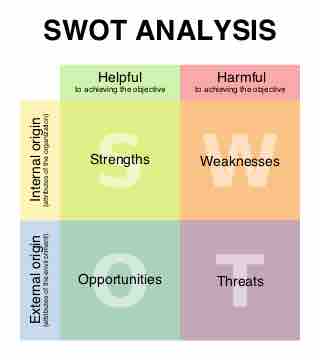Organizations must carefully consider what internal assets will differentiate them from the competition, within the same competitive environment. This internal analysis requires careful consideration of the following models and factors:
- Core mission
- Overall strategy
- Porter's competitive strategies
- SWOT analysis
- Forecasts
- Resource-based view

SWOT Analysis
Here is an example of the SWOT analysis matrix, which arranges strengths, weaknesses, opportunities, and threats.
Similarly, organizations must understand the context in which they operate if they aspire to acquire competitive advantage over other incumbents. Models such as the following outline these concerns effectively:
- Porter's five forces (and limitations)
- PESTEL and SCP
- Competitive dynamics
Merging Analyses for Competitive Advantage
These inputs generally outline each of the specific analyses a company should conduct to understand its internal and external environments. Combining these two constitutes context analysis, which is a method of analyzing the environment in which a business operates. Environmental scanning focuses mainly on the macro-environment of a business. Context analysis considers the entire environment of a business, both internal and external.
Using context analysis, alongside the necessary external and internal inputs, companies are able to generate strategies which actively capitalize on this knowledge in pursuit of competitive advantage. This strategic development requires companies to understand the opportunities and threats in the external environment and benchmark these against the strengths and weaknesses of their internal environment. By understanding how internal and external factors relate, companies can piece together the ideal way in which their strengths can capture opportunities while offsetting threats and rectifying weaknesses.
This melding of internal and external factors in pursuit of competitive advantage is an ongoing process, as the company must evolve and change in concert with the environment. As a result, strategic management is the process of constantly assessing both environments to ensure that the company retains a unique competitive position in which to generate value for stakeholders and customers. This implementation of strategies that take into account both the internal and external environments eventually achieves dynamic capabilities for the companies involved.
Change is costly, so firms must develop processes to find low pay-off changes. The ability to change depends on the ability to scan the environment, evaluate markets, and quickly accomplish reconfiguration and transformation ahead of the competition. These actions can be supported by decentralized structures, local autonomy, and strategic alliances.